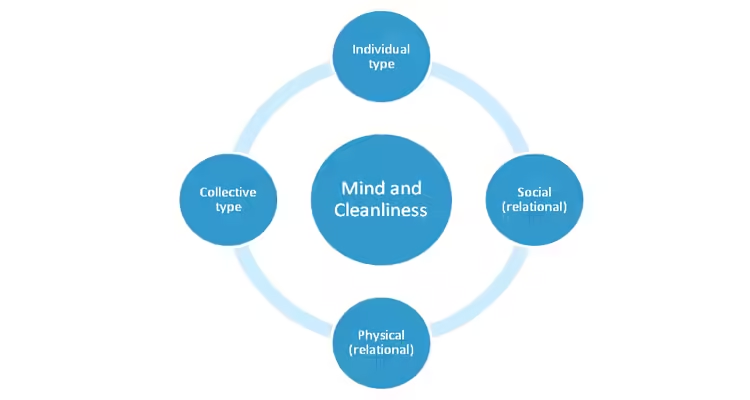
 On 2 October, Gandhi Jayanti is observed every year by celebrating Gandhiji’s ideology or remembering his contributions to the freedom of the country. But since 2014, this day has been designated as Swachh Bharat Divas to commemorate his idea of cleanliness. In a small village called BrahamanganinBhadrak district of Odisha, schools and one NGO celebrated the day as swachhata divas following the government’s decision. However, it was observed that the general public had no concern or interest in it, and they were busy in their daily routine work. The NGO called Mo Swechhasevi Sangathan organised the cleaning of temple fronts and a part of bazar areas. This is an NGO (unregistered) formed by a few youths who have come together nearly more than 15 years ago, contributing voluntarily to organize events like blood donation camps, environmental cleaning, organizing literacy and sports events for children, and helping victims of any disaster.
On 2 October, Gandhi Jayanti is observed every year by celebrating Gandhiji’s ideology or remembering his contributions to the freedom of the country. But since 2014, this day has been designated as Swachh Bharat Divas to commemorate his idea of cleanliness. In a small village called BrahamanganinBhadrak district of Odisha, schools and one NGO celebrated the day as swachhata divas following the government’s decision. However, it was observed that the general public had no concern or interest in it, and they were busy in their daily routine work. The NGO called Mo Swechhasevi Sangathan organised the cleaning of temple fronts and a part of bazar areas. This is an NGO (unregistered) formed by a few youths who have come together nearly more than 15 years ago, contributing voluntarily to organize events like blood donation camps, environmental cleaning, organizing literacy and sports events for children, and helping victims of any disaster.
The youths are motivated by one AnaryamiSahoo of the village who is working as a postal clerk in a post office in Koraput. What impressed me is their community sense, which they show in their own ways. No doubt there are like-minded youths everywhere waiting for a small spark to jump into the fire of doing something for society. I tried to understand their mind. They have a very strong zeal to serve society but without a comprehensive understanding of the issue. They are village youths, including students, but they are the ones on whose shoulders the future can rest safely, for they have no ambition and no craving for status except a sense of serving humanity. This may sound strange to many, but it is the reality I noticed and felt in a short interaction with a few of them involved in environmental cleaning on Gandhi Jayanti of 2024. They are self-less citizens of the country working to realise the government’s commitment, like Swachh Bharat Mission (SBM), in their own way.
Swachh Bharat Mission (SBM), a nation-wide campaign based on Gandhian ideology of cleanliness out of his threebasic teachingsnamely hygiene, swarajand abolition of untouchability, was launched by the Modi government on 2 October 2014. It is a significant move to eliminate open defecation, improve solid waste management, and create health awareness, particularly menstrual health management. The aim of eradicating open defecation has captured public attention through the movie Toilet- EkPremKahani of 2017. Another movie, released in 2023, named PanchKritialso focuses on five elements, of which environmental cleaning is an important component.
SBM is not entirely a new idea in government’s agenda. It had its precursors from 1947, mainly focusing on sanitation programmes of safe drinking water and elimination of open defecation. Subsequently, it extended its scope to Total Sanitation Campaign in 1999 under Vajpaye governmentand toNirmal Bharat Abhiyan in 2012 under Manmohan Singh government. The campaign from 2014 under the flagship of Swachh Bharat Mission, however, saw the commitmentand strong political will of the government. No doubt, various surveys conducted in the country report success stories of SBM.
Despite the success, somewhere, the campaign appears more as a ceremonial piety than a serious business. Indifference of the public in the village is an example. Politicians, celebrities, NGOs, sportspersons, and other ‘important persons’ are apparently involved more in photography than in real combating with the cause. Had they been serious, instead of posing for photos on special occasions to satisfy the Prime Minister, each of them would have adopted some villages or slums to combat the uncleanliness as a regular mission in daily life of the public. As far as the creation of public awareness is concerned, their involvement is meaningful, but to translate the awareness into action, their contribution has the least impact, for they are taken as a source that cannot be taken seriously.
Is it all about the SBM? Or is it a part of what Swachhata means? Let us try to understand.
Swachhata in terms of physical environmental cleanliness is a narrow conception. In its right perspective, it covers both social and physical environments. Social and physical cleanliness, in turn, requires mental cleanliness, as behind the idea and action of any physical or social cleanliness stands the mental stimulus—awareness, acceptance, and action. Swachhata involves individual and collective cleanliness at mental, social and physical fronts. Collective cleanliness refers to the sum total of individual cleanliness with regard to the relations in the family, community, and physical environment with which people interact individually and collectively. In this sense, swachhata refers to the purity of relations in physical and social environments. In terms of the relation with physical environment, people should not pollute the environment-air, land, and water in the process of interaction. Swachhata is nothing but a condition of harmonious relationships between individuals, society, and the physical environment.
Physical Swachhata primarily includes (I) Cleanliness of surroundings (free from waste and pollution), (ii) Sanitation (toilets, hygiene), (iii) Waste management (solid, liquid, plastic), and (iv) Environmental conservation. Individual swachhata includes purity in thought, action, attitude, and speech on one hand and physical cleanliness, including health management, on the other. Purity in relationships, whether social or physical, encompasses (i) social harmony (inclusivity, tolerance), (ii) interpersonal relationships (respect, empathy), (iii) community sense of belonging and engagement (participation, ownership), and (iv) environmental responsibility, stewardship, conservation, and a sense of ‘community of being’ or togetherness.
Swachhata in its broader meaning encompasses socio-cultural relations, focusing on purity in different relationships, such as (i) parent-child: nurturing, protection, love, respect, and guidance; (ii) siblings: mutual respect, care, and cooperation; (iii) family: shared responsibilities, understanding, and mutual support; and (iv) community: collective sense, sharing, and social cohesion. The first four refer to interpersonal swachhata. Swachhata in socio-cultural relations requires ethical and moral frameworks, such as justice, caring, liberty and freedom, etc., for realisation. The frameworks include respect, responsibility, empathy, compassion, inclusivity, non-violence, truthfulness and so on. Social Swachhata is very essential in Swachh Bharat Campaign because there are negative forces like inequality, caste hierarchy, gender discrimination, exploitation of relations, superior-inferior feelings, domination of the powerless, etc.
The core of SBM primarily aligns with three Sustainable Development Goals, namely clean water and sanitation, sustainable cities and communities, and responsible consumption and production. In this sense, it is a part of the all-encompassing meaning of swachhata in India’s tradition and has a narrow connotation and coverage in SBM. Unless mind is swachh (clean and pure in thought, action, and speech), achieving sustainable physical cleanliness will not be possible. What is crucial is an understanding of swachhata in a right and holistic perspective and formulating corresponding strategies for action. This holistic understanding is ingrained in the tagline SwabhavSwachhata, SanskarSwachhata. But unfortunately, swabhav (attitude, temperament; literarily ‘own-being’ or ‘own-becoming’) which reflects mental condition, and sanskar which reflects adherence to value, ethics, principles,etc. are at the back seat while SBM focuses on physical cleanliness like environmental cleaning and cleanliness in railways, schools, offices, parks, etc., as a commitment of the government. It is assumed that action will affect the mind in the right direction. But this has not happened. Despite all the efforts, people have not shunned the use of plastic bags! Untouchability has not been abolished from the root due to the mental perception of low-high social status between castes. Mind, therefore, needs to be swachh before cleansing the physical and social environments. In very few cases, the swachhta of mind propels the zeal for environmental cleanliness like the volunteers of Mo SwechhaseviSangathan, not the photo session of celebrities and politicians.
The importance of mind is evident when Gandhiji tried to change the perspective by linking cleanliness with godliness following John Wesley’s (1703-1791) sermon ‘On Dress’ (1786). His ideology has three dimensions: clean body, clean mind, and clean surroundings. The importance of mind also can be perceived from Swami Vivekananda’s saying:Purity of mind, purity of heart, and purity of action. Gandhiji has defined the relation of individuals with environment having ethical and moral sense which is nothing but strategy for a swachh relation with the environment. He stated:The earth has enough for everyone’s need, but not enough for everyone’s greed. Obviously, the adage speaks of mental supremacy. Action or awareness about physical cleaning does not ensure sustainable swacchta unless people change the attitude, a mental condition in deed.
(Written by Dr. Maguni Charan Behera; Rtd. Professor of Tribal Studies, email: mcbehera1959@gmail.com)



